Critical Analysis of Coles Supermarkets' Business Logistics Strategies
VerifiedAdded on 2022/12/16
|10
|2746
|72
Report
AI Summary
This report critically analyzes the logistics and supply chain management of Coles Supermarkets, a major Australian retail chain. The report begins by detailing two key strategies: Effective Consumer Response (ECR) and the Electronic Point of Sale (EPOS) system. It then identifies drawbacks such as the costs associated with point-of-sale systems and issues with omnichannel inventory management. Finally, the report recommends improvements using the theories of Forward Vertical Integration and Location Theory to enhance the company's supply chain, customer satisfaction, and overall performance in a competitive market. The report emphasizes the importance of customer focus and strategic location choices for maximizing sales and revenue.
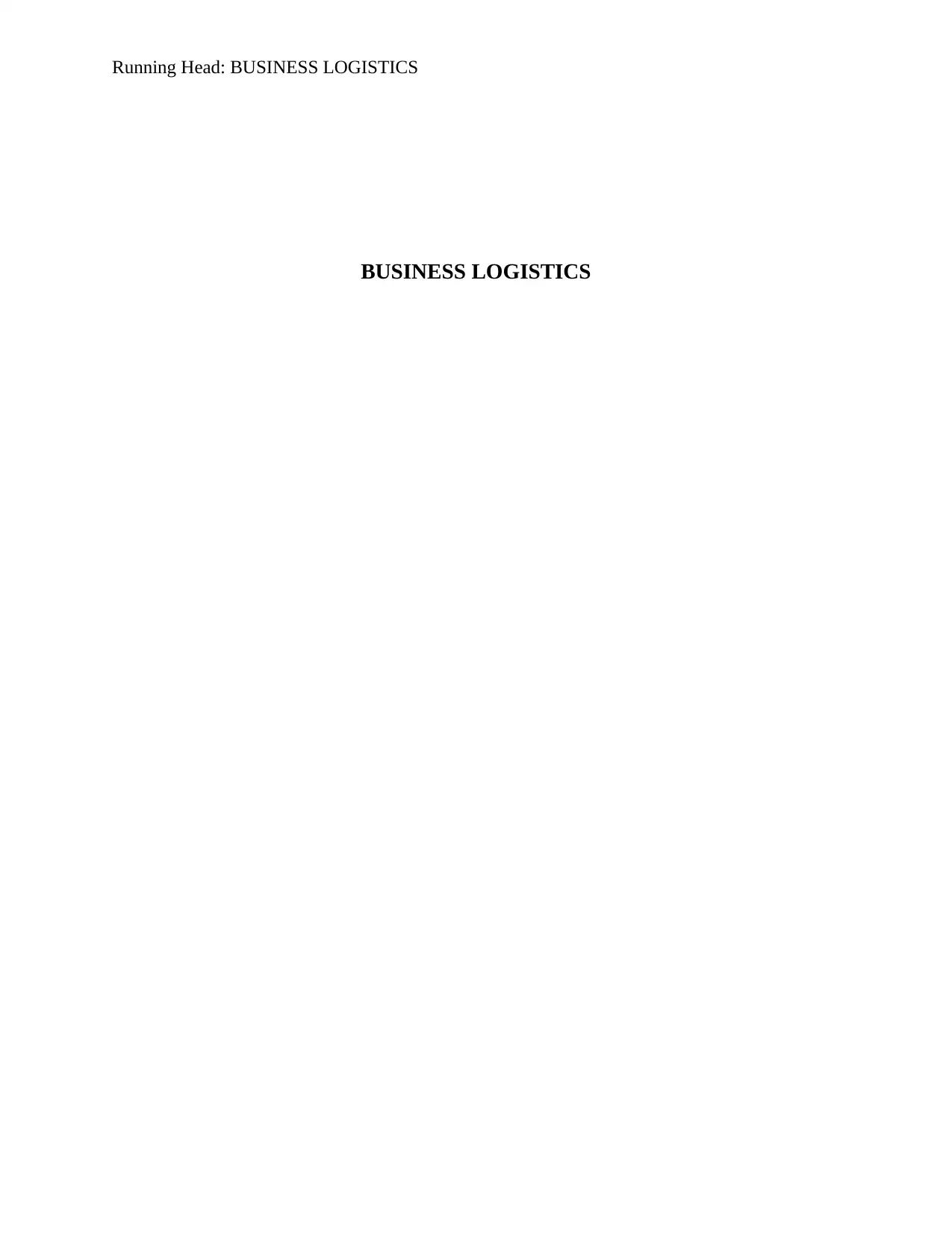
Running Head: BUSINESS LOGISTICS
BUSINESS LOGISTICS
BUSINESS LOGISTICS
Paraphrase This Document
Need a fresh take? Get an instant paraphrase of this document with our AI Paraphraser
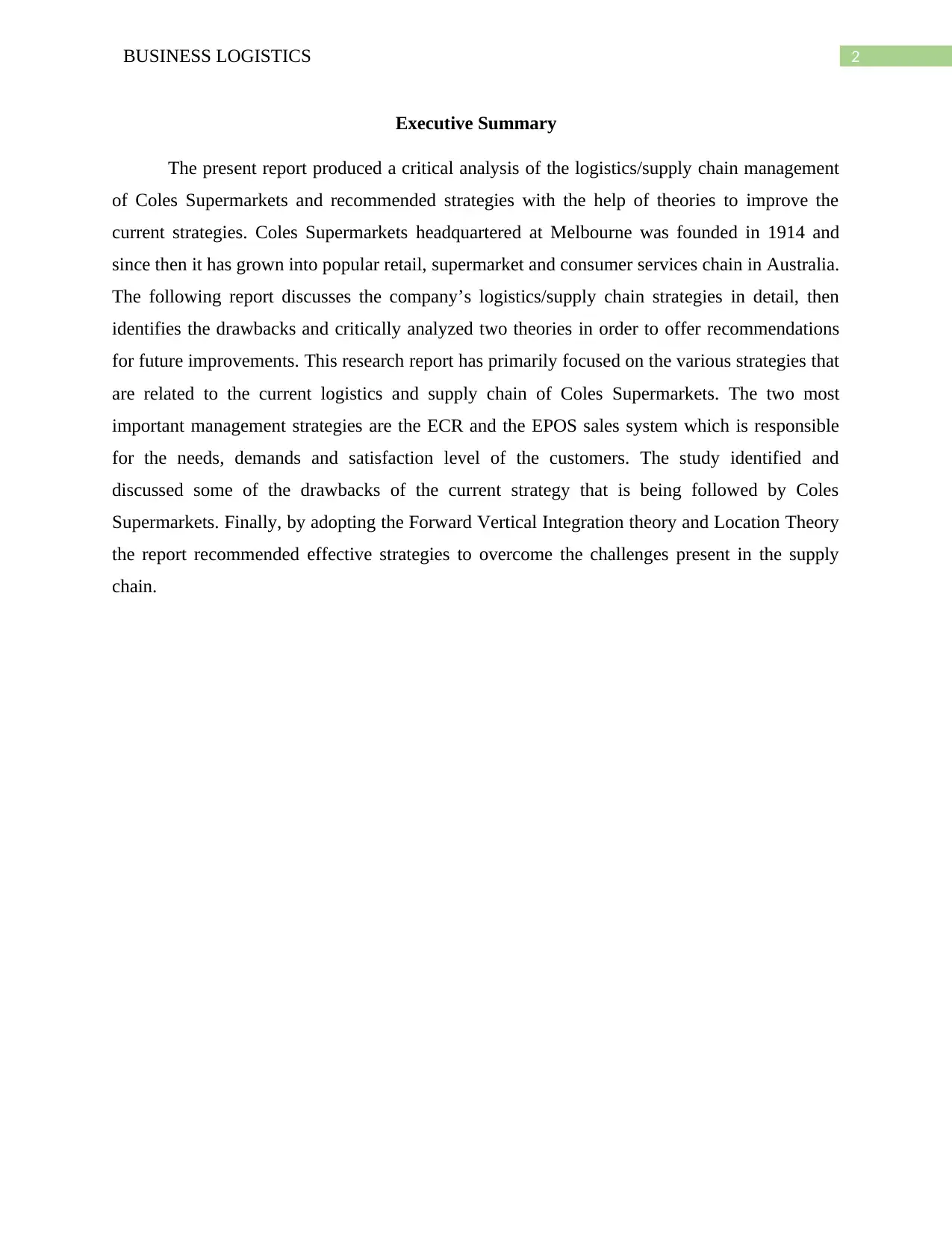
2BUSINESS LOGISTICS
Executive Summary
The present report produced a critical analysis of the logistics/supply chain management
of Coles Supermarkets and recommended strategies with the help of theories to improve the
current strategies. Coles Supermarkets headquartered at Melbourne was founded in 1914 and
since then it has grown into popular retail, supermarket and consumer services chain in Australia.
The following report discusses the company’s logistics/supply chain strategies in detail, then
identifies the drawbacks and critically analyzed two theories in order to offer recommendations
for future improvements. This research report has primarily focused on the various strategies that
are related to the current logistics and supply chain of Coles Supermarkets. The two most
important management strategies are the ECR and the EPOS sales system which is responsible
for the needs, demands and satisfaction level of the customers. The study identified and
discussed some of the drawbacks of the current strategy that is being followed by Coles
Supermarkets. Finally, by adopting the Forward Vertical Integration theory and Location Theory
the report recommended effective strategies to overcome the challenges present in the supply
chain.
Executive Summary
The present report produced a critical analysis of the logistics/supply chain management
of Coles Supermarkets and recommended strategies with the help of theories to improve the
current strategies. Coles Supermarkets headquartered at Melbourne was founded in 1914 and
since then it has grown into popular retail, supermarket and consumer services chain in Australia.
The following report discusses the company’s logistics/supply chain strategies in detail, then
identifies the drawbacks and critically analyzed two theories in order to offer recommendations
for future improvements. This research report has primarily focused on the various strategies that
are related to the current logistics and supply chain of Coles Supermarkets. The two most
important management strategies are the ECR and the EPOS sales system which is responsible
for the needs, demands and satisfaction level of the customers. The study identified and
discussed some of the drawbacks of the current strategy that is being followed by Coles
Supermarkets. Finally, by adopting the Forward Vertical Integration theory and Location Theory
the report recommended effective strategies to overcome the challenges present in the supply
chain.
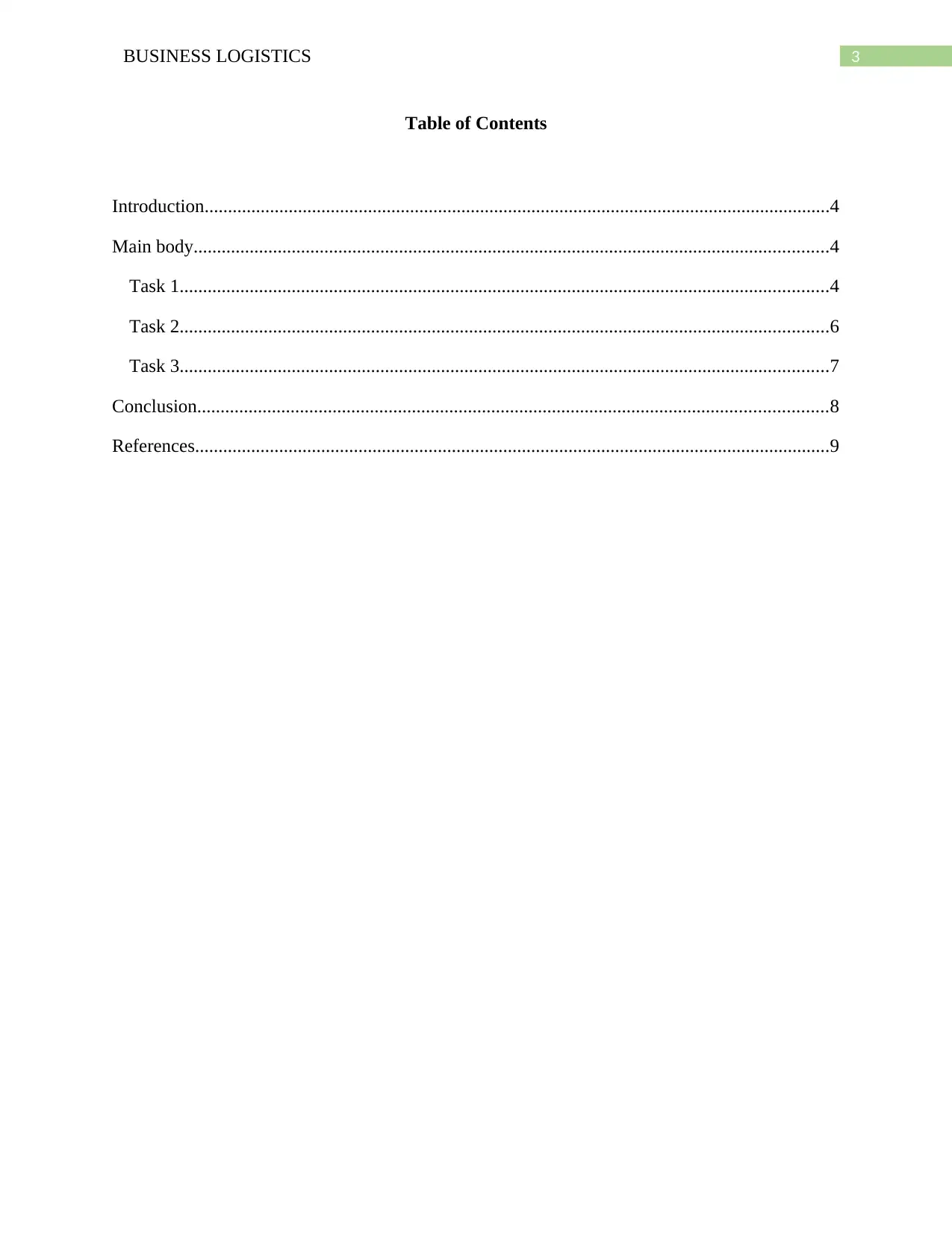
3BUSINESS LOGISTICS
Table of Contents
Introduction......................................................................................................................................4
Main body........................................................................................................................................4
Task 1...........................................................................................................................................4
Task 2...........................................................................................................................................6
Task 3...........................................................................................................................................7
Conclusion.......................................................................................................................................8
References........................................................................................................................................9
Table of Contents
Introduction......................................................................................................................................4
Main body........................................................................................................................................4
Task 1...........................................................................................................................................4
Task 2...........................................................................................................................................6
Task 3...........................................................................................................................................7
Conclusion.......................................................................................................................................8
References........................................................................................................................................9
You're viewing a preview
Unlock full access by subscribing today!
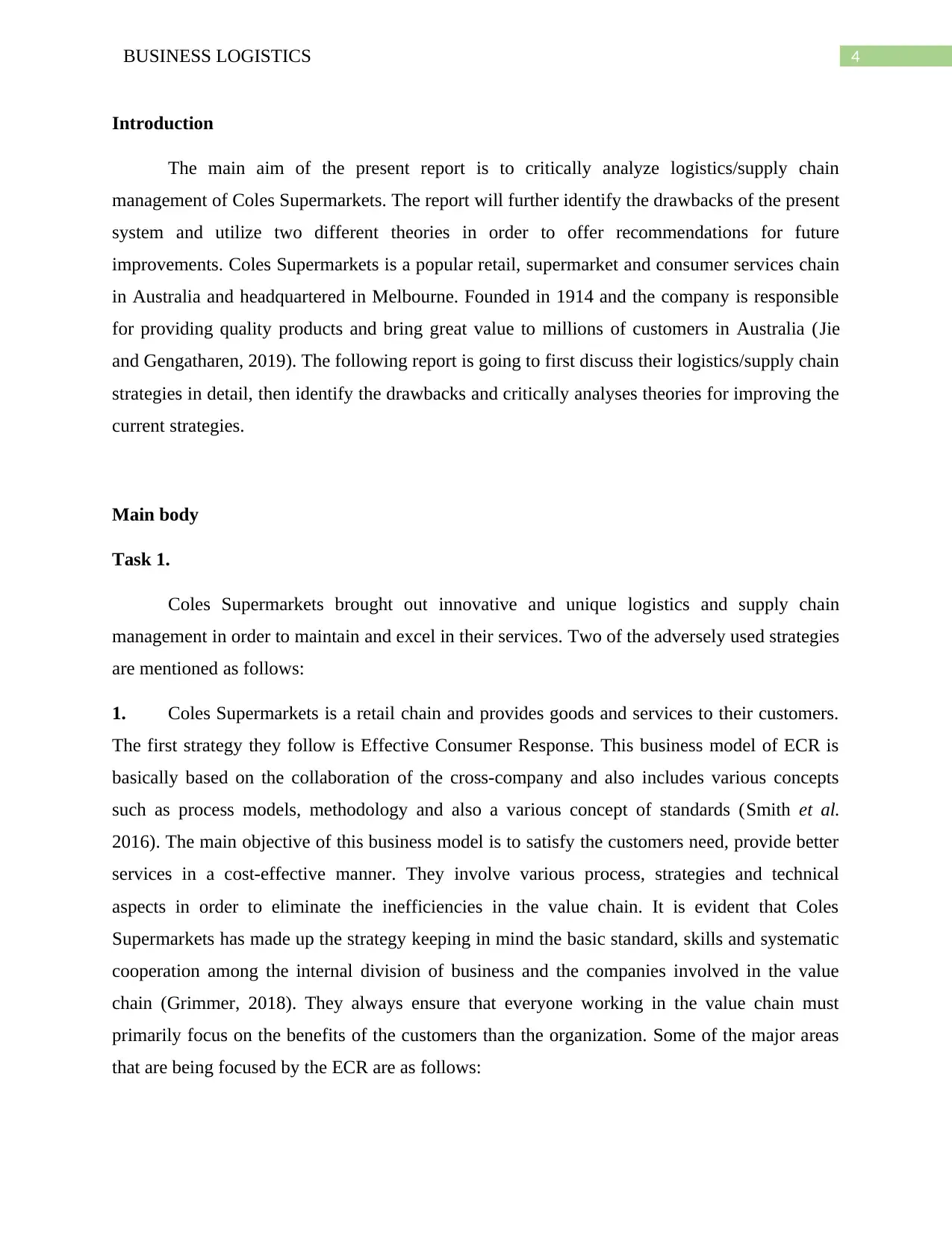
4BUSINESS LOGISTICS
Introduction
The main aim of the present report is to critically analyze logistics/supply chain
management of Coles Supermarkets. The report will further identify the drawbacks of the present
system and utilize two different theories in order to offer recommendations for future
improvements. Coles Supermarkets is a popular retail, supermarket and consumer services chain
in Australia and headquartered in Melbourne. Founded in 1914 and the company is responsible
for providing quality products and bring great value to millions of customers in Australia (Jie
and Gengatharen, 2019). The following report is going to first discuss their logistics/supply chain
strategies in detail, then identify the drawbacks and critically analyses theories for improving the
current strategies.
Main body
Task 1.
Coles Supermarkets brought out innovative and unique logistics and supply chain
management in order to maintain and excel in their services. Two of the adversely used strategies
are mentioned as follows:
1. Coles Supermarkets is a retail chain and provides goods and services to their customers.
The first strategy they follow is Effective Consumer Response. This business model of ECR is
basically based on the collaboration of the cross-company and also includes various concepts
such as process models, methodology and also a various concept of standards (Smith et al.
2016). The main objective of this business model is to satisfy the customers need, provide better
services in a cost-effective manner. They involve various process, strategies and technical
aspects in order to eliminate the inefficiencies in the value chain. It is evident that Coles
Supermarkets has made up the strategy keeping in mind the basic standard, skills and systematic
cooperation among the internal division of business and the companies involved in the value
chain (Grimmer, 2018). They always ensure that everyone working in the value chain must
primarily focus on the benefits of the customers than the organization. Some of the major areas
that are being focused by the ECR are as follows:
Introduction
The main aim of the present report is to critically analyze logistics/supply chain
management of Coles Supermarkets. The report will further identify the drawbacks of the present
system and utilize two different theories in order to offer recommendations for future
improvements. Coles Supermarkets is a popular retail, supermarket and consumer services chain
in Australia and headquartered in Melbourne. Founded in 1914 and the company is responsible
for providing quality products and bring great value to millions of customers in Australia (Jie
and Gengatharen, 2019). The following report is going to first discuss their logistics/supply chain
strategies in detail, then identify the drawbacks and critically analyses theories for improving the
current strategies.
Main body
Task 1.
Coles Supermarkets brought out innovative and unique logistics and supply chain
management in order to maintain and excel in their services. Two of the adversely used strategies
are mentioned as follows:
1. Coles Supermarkets is a retail chain and provides goods and services to their customers.
The first strategy they follow is Effective Consumer Response. This business model of ECR is
basically based on the collaboration of the cross-company and also includes various concepts
such as process models, methodology and also a various concept of standards (Smith et al.
2016). The main objective of this business model is to satisfy the customers need, provide better
services in a cost-effective manner. They involve various process, strategies and technical
aspects in order to eliminate the inefficiencies in the value chain. It is evident that Coles
Supermarkets has made up the strategy keeping in mind the basic standard, skills and systematic
cooperation among the internal division of business and the companies involved in the value
chain (Grimmer, 2018). They always ensure that everyone working in the value chain must
primarily focus on the benefits of the customers than the organization. Some of the major areas
that are being focused by the ECR are as follows:
Paraphrase This Document
Need a fresh take? Get an instant paraphrase of this document with our AI Paraphraser
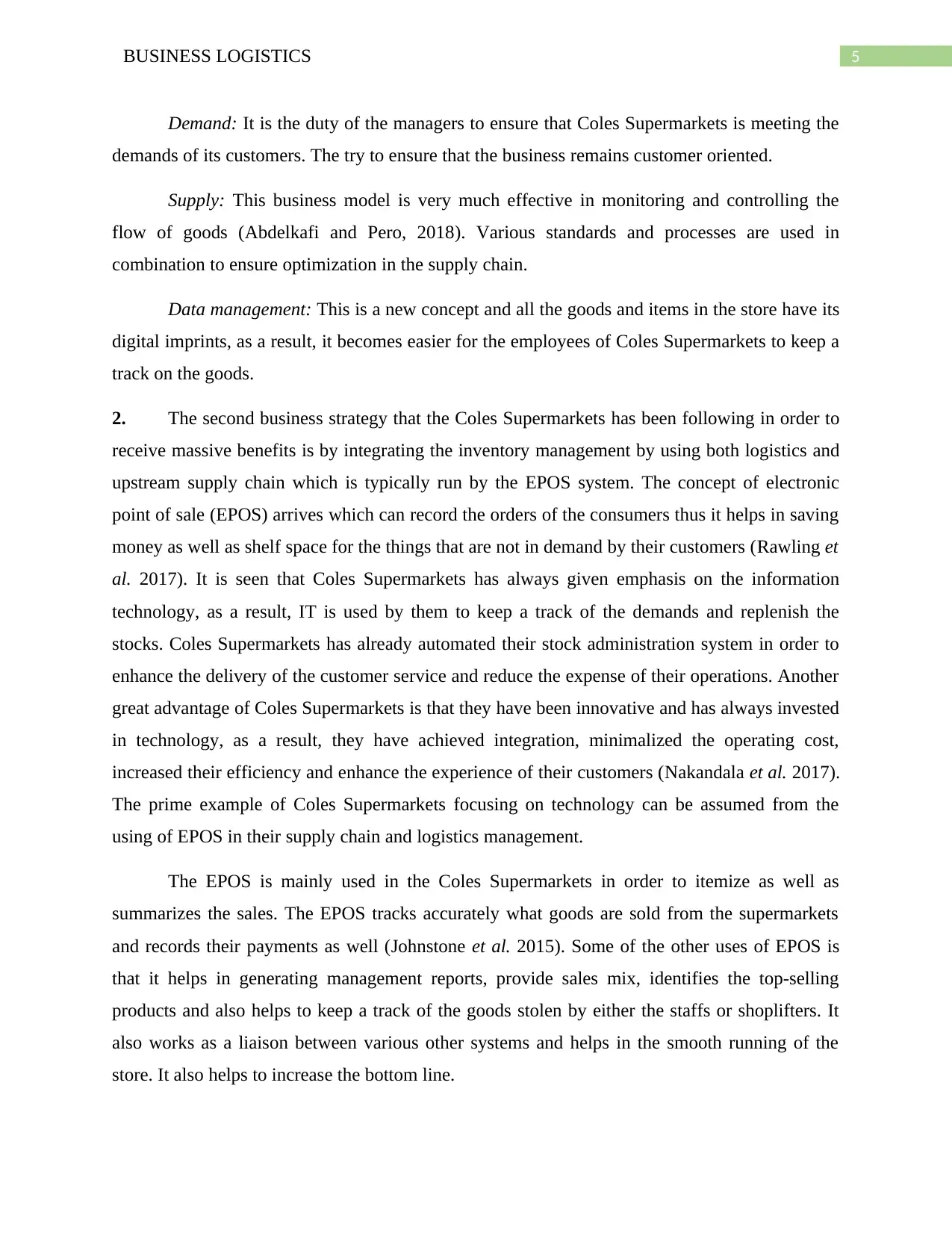
5BUSINESS LOGISTICS
Demand: It is the duty of the managers to ensure that Coles Supermarkets is meeting the
demands of its customers. The try to ensure that the business remains customer oriented.
Supply: This business model is very much effective in monitoring and controlling the
flow of goods (Abdelkafi and Pero, 2018). Various standards and processes are used in
combination to ensure optimization in the supply chain.
Data management: This is a new concept and all the goods and items in the store have its
digital imprints, as a result, it becomes easier for the employees of Coles Supermarkets to keep a
track on the goods.
2. The second business strategy that the Coles Supermarkets has been following in order to
receive massive benefits is by integrating the inventory management by using both logistics and
upstream supply chain which is typically run by the EPOS system. The concept of electronic
point of sale (EPOS) arrives which can record the orders of the consumers thus it helps in saving
money as well as shelf space for the things that are not in demand by their customers (Rawling et
al. 2017). It is seen that Coles Supermarkets has always given emphasis on the information
technology, as a result, IT is used by them to keep a track of the demands and replenish the
stocks. Coles Supermarkets has already automated their stock administration system in order to
enhance the delivery of the customer service and reduce the expense of their operations. Another
great advantage of Coles Supermarkets is that they have been innovative and has always invested
in technology, as a result, they have achieved integration, minimalized the operating cost,
increased their efficiency and enhance the experience of their customers (Nakandala et al. 2017).
The prime example of Coles Supermarkets focusing on technology can be assumed from the
using of EPOS in their supply chain and logistics management.
The EPOS is mainly used in the Coles Supermarkets in order to itemize as well as
summarizes the sales. The EPOS tracks accurately what goods are sold from the supermarkets
and records their payments as well (Johnstone et al. 2015). Some of the other uses of EPOS is
that it helps in generating management reports, provide sales mix, identifies the top-selling
products and also helps to keep a track of the goods stolen by either the staffs or shoplifters. It
also works as a liaison between various other systems and helps in the smooth running of the
store. It also helps to increase the bottom line.
Demand: It is the duty of the managers to ensure that Coles Supermarkets is meeting the
demands of its customers. The try to ensure that the business remains customer oriented.
Supply: This business model is very much effective in monitoring and controlling the
flow of goods (Abdelkafi and Pero, 2018). Various standards and processes are used in
combination to ensure optimization in the supply chain.
Data management: This is a new concept and all the goods and items in the store have its
digital imprints, as a result, it becomes easier for the employees of Coles Supermarkets to keep a
track on the goods.
2. The second business strategy that the Coles Supermarkets has been following in order to
receive massive benefits is by integrating the inventory management by using both logistics and
upstream supply chain which is typically run by the EPOS system. The concept of electronic
point of sale (EPOS) arrives which can record the orders of the consumers thus it helps in saving
money as well as shelf space for the things that are not in demand by their customers (Rawling et
al. 2017). It is seen that Coles Supermarkets has always given emphasis on the information
technology, as a result, IT is used by them to keep a track of the demands and replenish the
stocks. Coles Supermarkets has already automated their stock administration system in order to
enhance the delivery of the customer service and reduce the expense of their operations. Another
great advantage of Coles Supermarkets is that they have been innovative and has always invested
in technology, as a result, they have achieved integration, minimalized the operating cost,
increased their efficiency and enhance the experience of their customers (Nakandala et al. 2017).
The prime example of Coles Supermarkets focusing on technology can be assumed from the
using of EPOS in their supply chain and logistics management.
The EPOS is mainly used in the Coles Supermarkets in order to itemize as well as
summarizes the sales. The EPOS tracks accurately what goods are sold from the supermarkets
and records their payments as well (Johnstone et al. 2015). Some of the other uses of EPOS is
that it helps in generating management reports, provide sales mix, identifies the top-selling
products and also helps to keep a track of the goods stolen by either the staffs or shoplifters. It
also works as a liaison between various other systems and helps in the smooth running of the
store. It also helps to increase the bottom line.
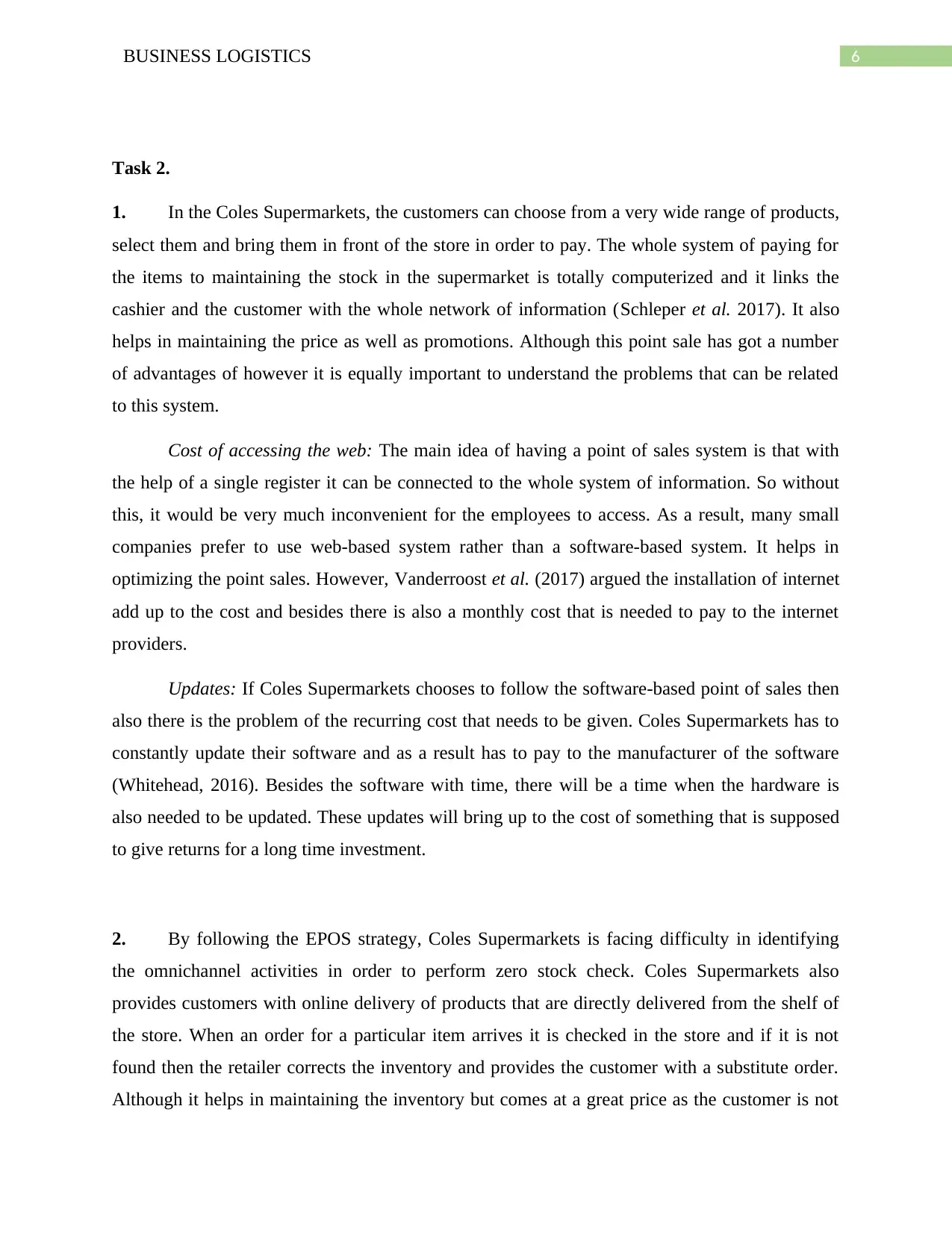
6BUSINESS LOGISTICS
Task 2.
1. In the Coles Supermarkets, the customers can choose from a very wide range of products,
select them and bring them in front of the store in order to pay. The whole system of paying for
the items to maintaining the stock in the supermarket is totally computerized and it links the
cashier and the customer with the whole network of information (Schleper et al. 2017). It also
helps in maintaining the price as well as promotions. Although this point sale has got a number
of advantages of however it is equally important to understand the problems that can be related
to this system.
Cost of accessing the web: The main idea of having a point of sales system is that with
the help of a single register it can be connected to the whole system of information. So without
this, it would be very much inconvenient for the employees to access. As a result, many small
companies prefer to use web-based system rather than a software-based system. It helps in
optimizing the point sales. However, Vanderroost et al. (2017) argued the installation of internet
add up to the cost and besides there is also a monthly cost that is needed to pay to the internet
providers.
Updates: If Coles Supermarkets chooses to follow the software-based point of sales then
also there is the problem of the recurring cost that needs to be given. Coles Supermarkets has to
constantly update their software and as a result has to pay to the manufacturer of the software
(Whitehead, 2016). Besides the software with time, there will be a time when the hardware is
also needed to be updated. These updates will bring up to the cost of something that is supposed
to give returns for a long time investment.
2. By following the EPOS strategy, Coles Supermarkets is facing difficulty in identifying
the omnichannel activities in order to perform zero stock check. Coles Supermarkets also
provides customers with online delivery of products that are directly delivered from the shelf of
the store. When an order for a particular item arrives it is checked in the store and if it is not
found then the retailer corrects the inventory and provides the customer with a substitute order.
Although it helps in maintaining the inventory but comes at a great price as the customer is not
Task 2.
1. In the Coles Supermarkets, the customers can choose from a very wide range of products,
select them and bring them in front of the store in order to pay. The whole system of paying for
the items to maintaining the stock in the supermarket is totally computerized and it links the
cashier and the customer with the whole network of information (Schleper et al. 2017). It also
helps in maintaining the price as well as promotions. Although this point sale has got a number
of advantages of however it is equally important to understand the problems that can be related
to this system.
Cost of accessing the web: The main idea of having a point of sales system is that with
the help of a single register it can be connected to the whole system of information. So without
this, it would be very much inconvenient for the employees to access. As a result, many small
companies prefer to use web-based system rather than a software-based system. It helps in
optimizing the point sales. However, Vanderroost et al. (2017) argued the installation of internet
add up to the cost and besides there is also a monthly cost that is needed to pay to the internet
providers.
Updates: If Coles Supermarkets chooses to follow the software-based point of sales then
also there is the problem of the recurring cost that needs to be given. Coles Supermarkets has to
constantly update their software and as a result has to pay to the manufacturer of the software
(Whitehead, 2016). Besides the software with time, there will be a time when the hardware is
also needed to be updated. These updates will bring up to the cost of something that is supposed
to give returns for a long time investment.
2. By following the EPOS strategy, Coles Supermarkets is facing difficulty in identifying
the omnichannel activities in order to perform zero stock check. Coles Supermarkets also
provides customers with online delivery of products that are directly delivered from the shelf of
the store. When an order for a particular item arrives it is checked in the store and if it is not
found then the retailer corrects the inventory and provides the customer with a substitute order.
Although it helps in maintaining the inventory but comes at a great price as the customer is not
You're viewing a preview
Unlock full access by subscribing today!
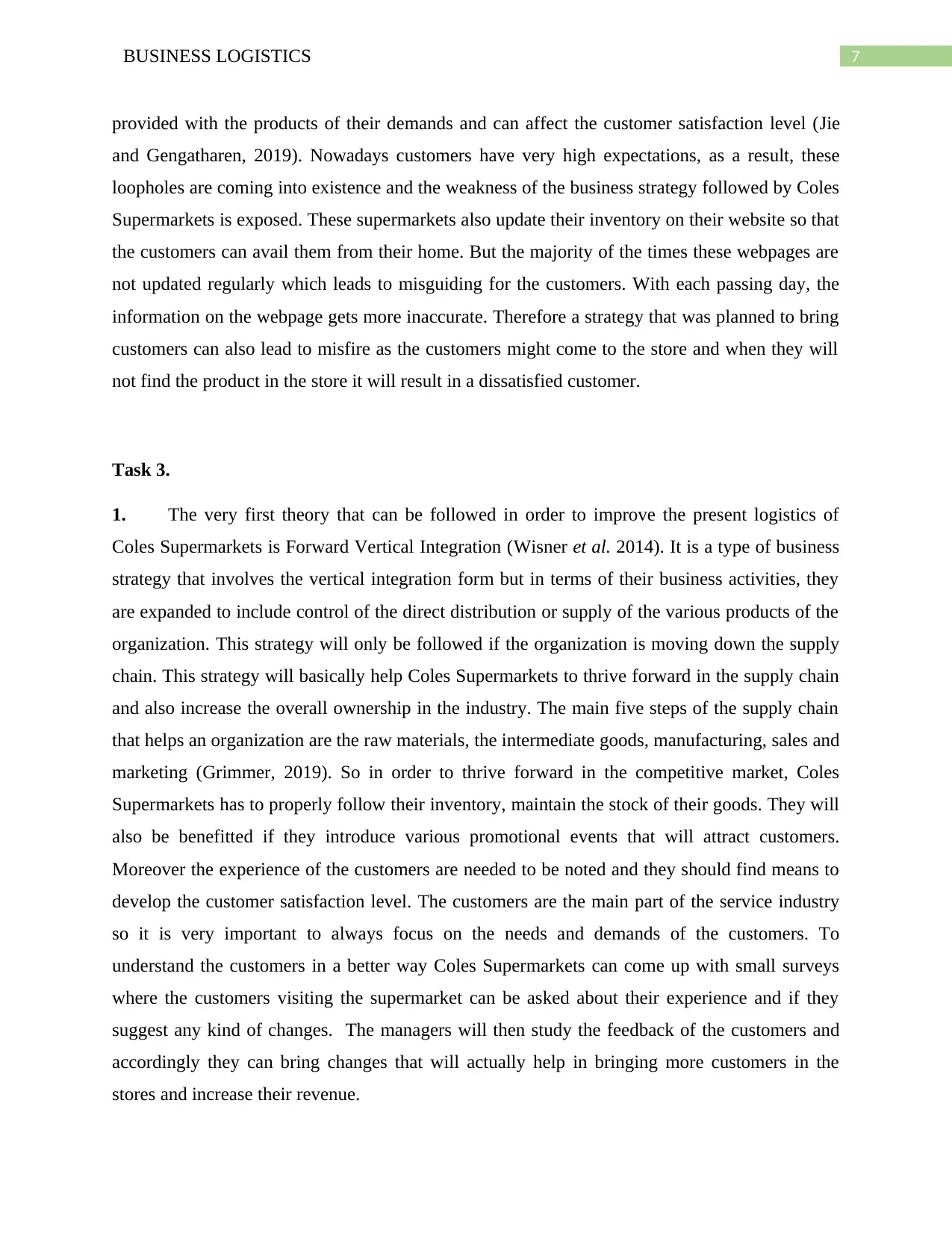
7BUSINESS LOGISTICS
provided with the products of their demands and can affect the customer satisfaction level (Jie
and Gengatharen, 2019). Nowadays customers have very high expectations, as a result, these
loopholes are coming into existence and the weakness of the business strategy followed by Coles
Supermarkets is exposed. These supermarkets also update their inventory on their website so that
the customers can avail them from their home. But the majority of the times these webpages are
not updated regularly which leads to misguiding for the customers. With each passing day, the
information on the webpage gets more inaccurate. Therefore a strategy that was planned to bring
customers can also lead to misfire as the customers might come to the store and when they will
not find the product in the store it will result in a dissatisfied customer.
Task 3.
1. The very first theory that can be followed in order to improve the present logistics of
Coles Supermarkets is Forward Vertical Integration (Wisner et al. 2014). It is a type of business
strategy that involves the vertical integration form but in terms of their business activities, they
are expanded to include control of the direct distribution or supply of the various products of the
organization. This strategy will only be followed if the organization is moving down the supply
chain. This strategy will basically help Coles Supermarkets to thrive forward in the supply chain
and also increase the overall ownership in the industry. The main five steps of the supply chain
that helps an organization are the raw materials, the intermediate goods, manufacturing, sales and
marketing (Grimmer, 2019). So in order to thrive forward in the competitive market, Coles
Supermarkets has to properly follow their inventory, maintain the stock of their goods. They will
also be benefitted if they introduce various promotional events that will attract customers.
Moreover the experience of the customers are needed to be noted and they should find means to
develop the customer satisfaction level. The customers are the main part of the service industry
so it is very important to always focus on the needs and demands of the customers. To
understand the customers in a better way Coles Supermarkets can come up with small surveys
where the customers visiting the supermarket can be asked about their experience and if they
suggest any kind of changes. The managers will then study the feedback of the customers and
accordingly they can bring changes that will actually help in bringing more customers in the
stores and increase their revenue.
provided with the products of their demands and can affect the customer satisfaction level (Jie
and Gengatharen, 2019). Nowadays customers have very high expectations, as a result, these
loopholes are coming into existence and the weakness of the business strategy followed by Coles
Supermarkets is exposed. These supermarkets also update their inventory on their website so that
the customers can avail them from their home. But the majority of the times these webpages are
not updated regularly which leads to misguiding for the customers. With each passing day, the
information on the webpage gets more inaccurate. Therefore a strategy that was planned to bring
customers can also lead to misfire as the customers might come to the store and when they will
not find the product in the store it will result in a dissatisfied customer.
Task 3.
1. The very first theory that can be followed in order to improve the present logistics of
Coles Supermarkets is Forward Vertical Integration (Wisner et al. 2014). It is a type of business
strategy that involves the vertical integration form but in terms of their business activities, they
are expanded to include control of the direct distribution or supply of the various products of the
organization. This strategy will only be followed if the organization is moving down the supply
chain. This strategy will basically help Coles Supermarkets to thrive forward in the supply chain
and also increase the overall ownership in the industry. The main five steps of the supply chain
that helps an organization are the raw materials, the intermediate goods, manufacturing, sales and
marketing (Grimmer, 2019). So in order to thrive forward in the competitive market, Coles
Supermarkets has to properly follow their inventory, maintain the stock of their goods. They will
also be benefitted if they introduce various promotional events that will attract customers.
Moreover the experience of the customers are needed to be noted and they should find means to
develop the customer satisfaction level. The customers are the main part of the service industry
so it is very important to always focus on the needs and demands of the customers. To
understand the customers in a better way Coles Supermarkets can come up with small surveys
where the customers visiting the supermarket can be asked about their experience and if they
suggest any kind of changes. The managers will then study the feedback of the customers and
accordingly they can bring changes that will actually help in bringing more customers in the
stores and increase their revenue.
Paraphrase This Document
Need a fresh take? Get an instant paraphrase of this document with our AI Paraphraser
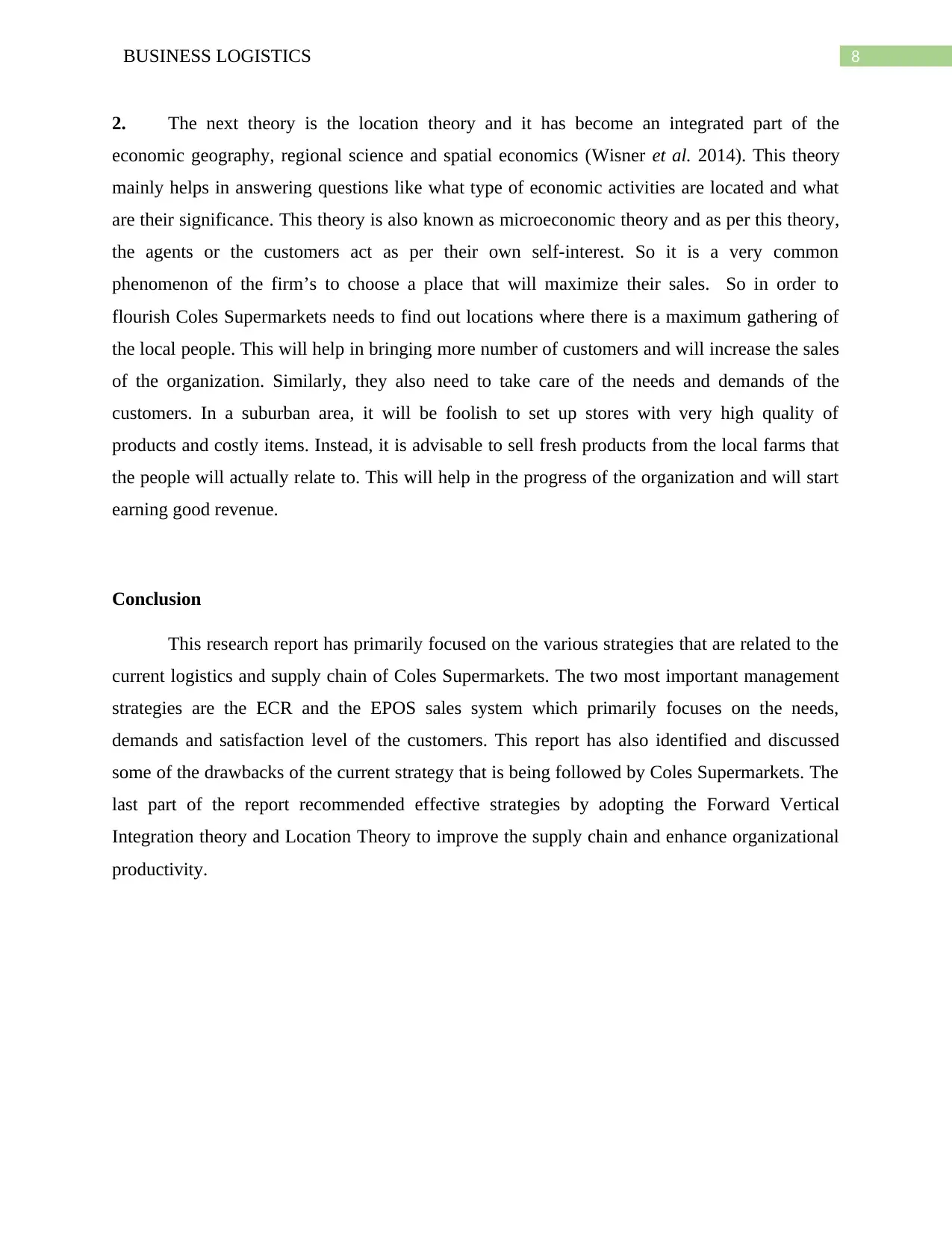
8BUSINESS LOGISTICS
2. The next theory is the location theory and it has become an integrated part of the
economic geography, regional science and spatial economics (Wisner et al. 2014). This theory
mainly helps in answering questions like what type of economic activities are located and what
are their significance. This theory is also known as microeconomic theory and as per this theory,
the agents or the customers act as per their own self-interest. So it is a very common
phenomenon of the firm’s to choose a place that will maximize their sales. So in order to
flourish Coles Supermarkets needs to find out locations where there is a maximum gathering of
the local people. This will help in bringing more number of customers and will increase the sales
of the organization. Similarly, they also need to take care of the needs and demands of the
customers. In a suburban area, it will be foolish to set up stores with very high quality of
products and costly items. Instead, it is advisable to sell fresh products from the local farms that
the people will actually relate to. This will help in the progress of the organization and will start
earning good revenue.
Conclusion
This research report has primarily focused on the various strategies that are related to the
current logistics and supply chain of Coles Supermarkets. The two most important management
strategies are the ECR and the EPOS sales system which primarily focuses on the needs,
demands and satisfaction level of the customers. This report has also identified and discussed
some of the drawbacks of the current strategy that is being followed by Coles Supermarkets. The
last part of the report recommended effective strategies by adopting the Forward Vertical
Integration theory and Location Theory to improve the supply chain and enhance organizational
productivity.
2. The next theory is the location theory and it has become an integrated part of the
economic geography, regional science and spatial economics (Wisner et al. 2014). This theory
mainly helps in answering questions like what type of economic activities are located and what
are their significance. This theory is also known as microeconomic theory and as per this theory,
the agents or the customers act as per their own self-interest. So it is a very common
phenomenon of the firm’s to choose a place that will maximize their sales. So in order to
flourish Coles Supermarkets needs to find out locations where there is a maximum gathering of
the local people. This will help in bringing more number of customers and will increase the sales
of the organization. Similarly, they also need to take care of the needs and demands of the
customers. In a suburban area, it will be foolish to set up stores with very high quality of
products and costly items. Instead, it is advisable to sell fresh products from the local farms that
the people will actually relate to. This will help in the progress of the organization and will start
earning good revenue.
Conclusion
This research report has primarily focused on the various strategies that are related to the
current logistics and supply chain of Coles Supermarkets. The two most important management
strategies are the ECR and the EPOS sales system which primarily focuses on the needs,
demands and satisfaction level of the customers. This report has also identified and discussed
some of the drawbacks of the current strategy that is being followed by Coles Supermarkets. The
last part of the report recommended effective strategies by adopting the Forward Vertical
Integration theory and Location Theory to improve the supply chain and enhance organizational
productivity.
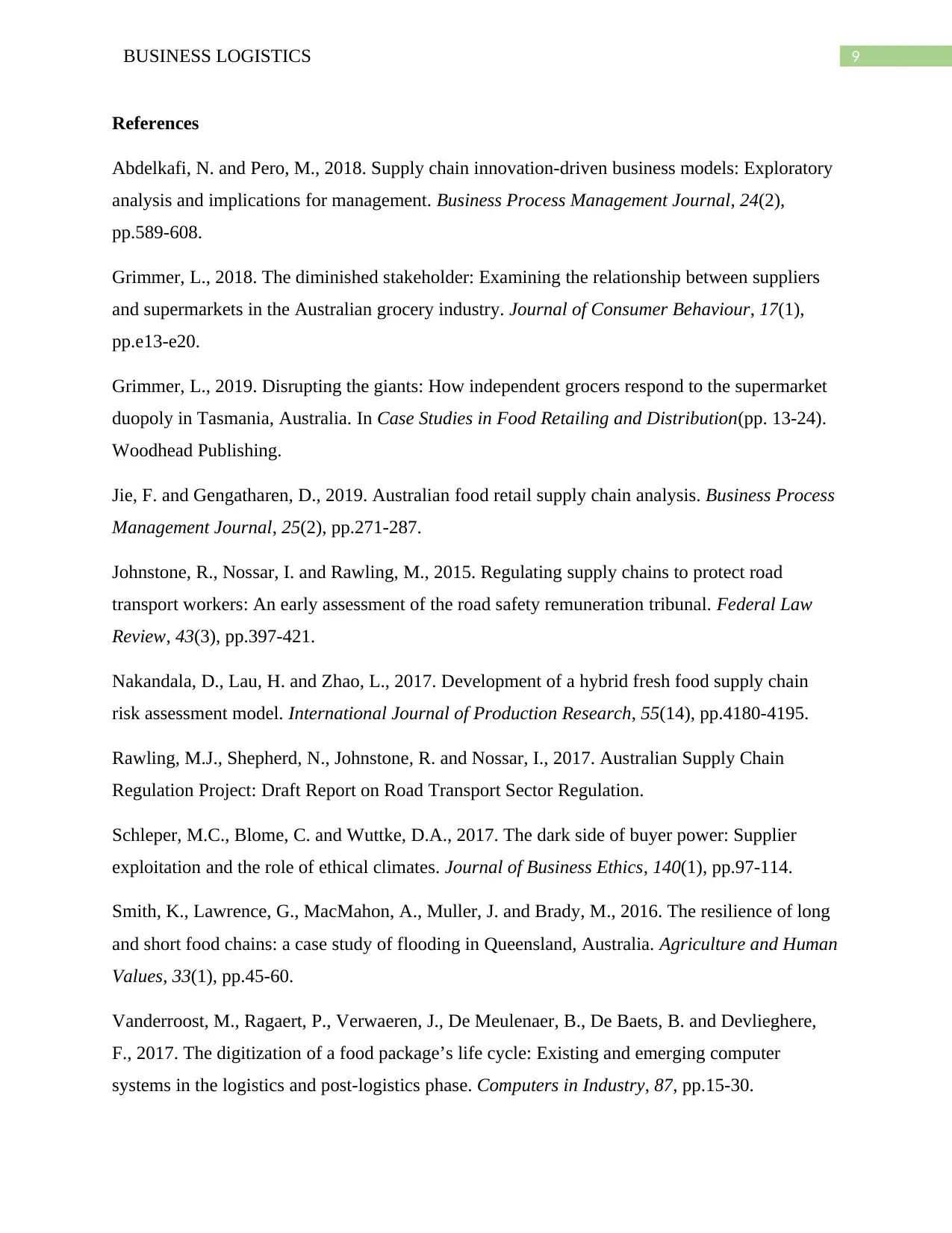
9BUSINESS LOGISTICS
References
Abdelkafi, N. and Pero, M., 2018. Supply chain innovation-driven business models: Exploratory
analysis and implications for management. Business Process Management Journal, 24(2),
pp.589-608.
Grimmer, L., 2018. The diminished stakeholder: Examining the relationship between suppliers
and supermarkets in the Australian grocery industry. Journal of Consumer Behaviour, 17(1),
pp.e13-e20.
Grimmer, L., 2019. Disrupting the giants: How independent grocers respond to the supermarket
duopoly in Tasmania, Australia. In Case Studies in Food Retailing and Distribution(pp. 13-24).
Woodhead Publishing.
Jie, F. and Gengatharen, D., 2019. Australian food retail supply chain analysis. Business Process
Management Journal, 25(2), pp.271-287.
Johnstone, R., Nossar, I. and Rawling, M., 2015. Regulating supply chains to protect road
transport workers: An early assessment of the road safety remuneration tribunal. Federal Law
Review, 43(3), pp.397-421.
Nakandala, D., Lau, H. and Zhao, L., 2017. Development of a hybrid fresh food supply chain
risk assessment model. International Journal of Production Research, 55(14), pp.4180-4195.
Rawling, M.J., Shepherd, N., Johnstone, R. and Nossar, I., 2017. Australian Supply Chain
Regulation Project: Draft Report on Road Transport Sector Regulation.
Schleper, M.C., Blome, C. and Wuttke, D.A., 2017. The dark side of buyer power: Supplier
exploitation and the role of ethical climates. Journal of Business Ethics, 140(1), pp.97-114.
Smith, K., Lawrence, G., MacMahon, A., Muller, J. and Brady, M., 2016. The resilience of long
and short food chains: a case study of flooding in Queensland, Australia. Agriculture and Human
Values, 33(1), pp.45-60.
Vanderroost, M., Ragaert, P., Verwaeren, J., De Meulenaer, B., De Baets, B. and Devlieghere,
F., 2017. The digitization of a food package’s life cycle: Existing and emerging computer
systems in the logistics and post-logistics phase. Computers in Industry, 87, pp.15-30.
References
Abdelkafi, N. and Pero, M., 2018. Supply chain innovation-driven business models: Exploratory
analysis and implications for management. Business Process Management Journal, 24(2),
pp.589-608.
Grimmer, L., 2018. The diminished stakeholder: Examining the relationship between suppliers
and supermarkets in the Australian grocery industry. Journal of Consumer Behaviour, 17(1),
pp.e13-e20.
Grimmer, L., 2019. Disrupting the giants: How independent grocers respond to the supermarket
duopoly in Tasmania, Australia. In Case Studies in Food Retailing and Distribution(pp. 13-24).
Woodhead Publishing.
Jie, F. and Gengatharen, D., 2019. Australian food retail supply chain analysis. Business Process
Management Journal, 25(2), pp.271-287.
Johnstone, R., Nossar, I. and Rawling, M., 2015. Regulating supply chains to protect road
transport workers: An early assessment of the road safety remuneration tribunal. Federal Law
Review, 43(3), pp.397-421.
Nakandala, D., Lau, H. and Zhao, L., 2017. Development of a hybrid fresh food supply chain
risk assessment model. International Journal of Production Research, 55(14), pp.4180-4195.
Rawling, M.J., Shepherd, N., Johnstone, R. and Nossar, I., 2017. Australian Supply Chain
Regulation Project: Draft Report on Road Transport Sector Regulation.
Schleper, M.C., Blome, C. and Wuttke, D.A., 2017. The dark side of buyer power: Supplier
exploitation and the role of ethical climates. Journal of Business Ethics, 140(1), pp.97-114.
Smith, K., Lawrence, G., MacMahon, A., Muller, J. and Brady, M., 2016. The resilience of long
and short food chains: a case study of flooding in Queensland, Australia. Agriculture and Human
Values, 33(1), pp.45-60.
Vanderroost, M., Ragaert, P., Verwaeren, J., De Meulenaer, B., De Baets, B. and Devlieghere,
F., 2017. The digitization of a food package’s life cycle: Existing and emerging computer
systems in the logistics and post-logistics phase. Computers in Industry, 87, pp.15-30.
You're viewing a preview
Unlock full access by subscribing today!
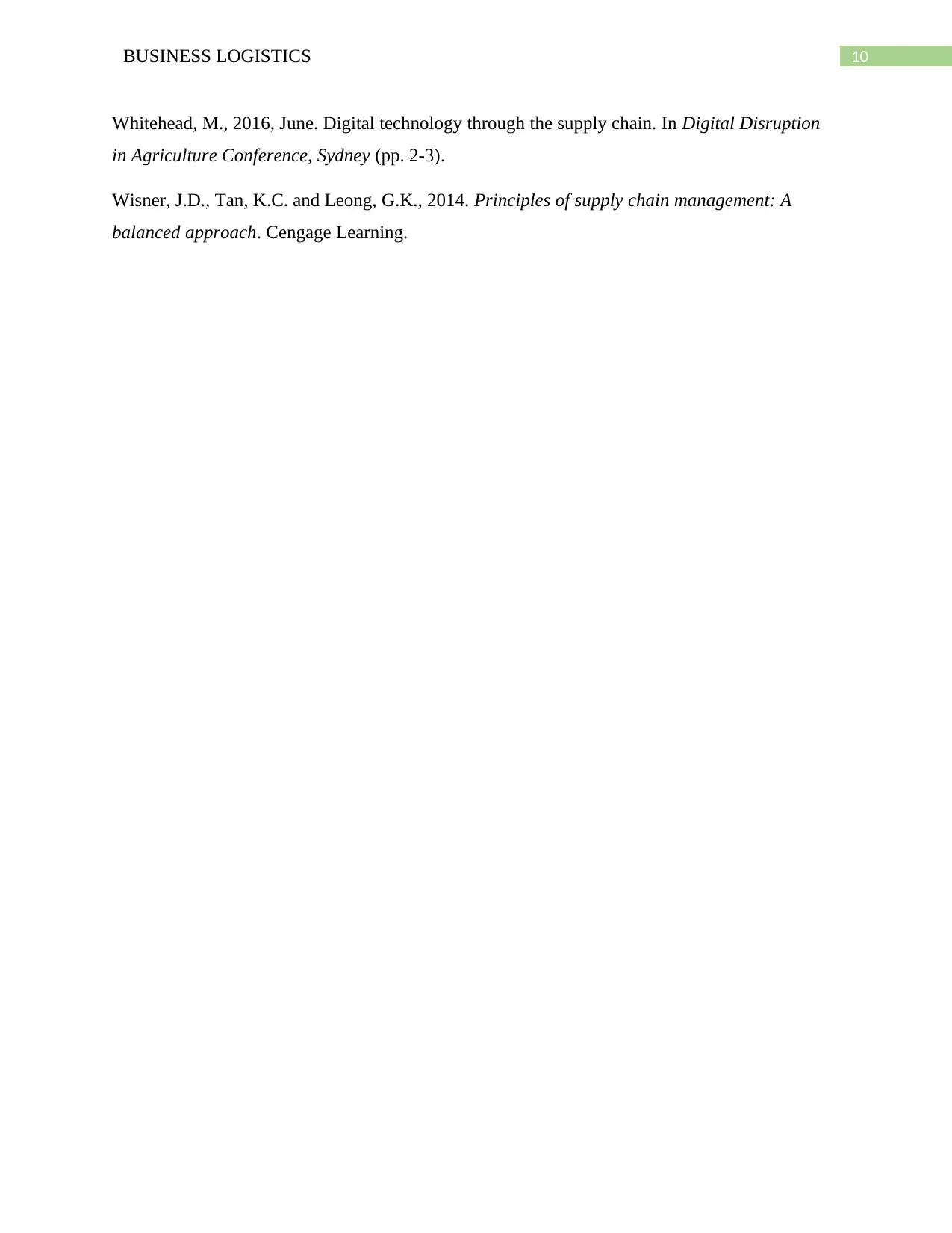
10BUSINESS LOGISTICS
Whitehead, M., 2016, June. Digital technology through the supply chain. In Digital Disruption
in Agriculture Conference, Sydney (pp. 2-3).
Wisner, J.D., Tan, K.C. and Leong, G.K., 2014. Principles of supply chain management: A
balanced approach. Cengage Learning.
Whitehead, M., 2016, June. Digital technology through the supply chain. In Digital Disruption
in Agriculture Conference, Sydney (pp. 2-3).
Wisner, J.D., Tan, K.C. and Leong, G.K., 2014. Principles of supply chain management: A
balanced approach. Cengage Learning.
1 out of 10
Related Documents
Your All-in-One AI-Powered Toolkit for Academic Success.
+13062052269
info@desklib.com
Available 24*7 on WhatsApp / Email
![[object Object]](/_next/static/media/star-bottom.7253800d.svg)
Unlock your academic potential
© 2024 | Zucol Services PVT LTD | All rights reserved.





